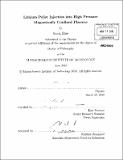| dc.contributor.advisor | Earl Marmar. | en_US |
| dc.contributor.author | Böse, Brock (Brock Darrel) | en_US |
| dc.contributor.other | Massachusetts Institute of Technology. Dept. of Physics. | en_US |
| dc.date.accessioned | 2011-05-09T15:13:09Z | |
| dc.date.available | 2011-05-09T15:13:09Z | |
| dc.date.copyright | 2010 | en_US |
| dc.date.issued | 2010 | en_US |
| dc.identifier.uri | http://hdl.handle.net/1721.1/62642 | |
| dc.description | Thesis (Ph. D.)--Massachusetts Institute of Technology, Dept. of Physics, 2010. | en_US |
| dc.description | Cataloged from PDF version of thesis. | en_US |
| dc.description | Includes bibliographical references (p. 195-201). | en_US |
| dc.description.abstract | The ablation of solid pellets injected into high temperature magnetically confined plasmas is characterized by rapid oscillations in the ablation rate, and the formation of field aligned filaments in the ablatant. High speed imaging of the ablation (> 250, 000 frames/second) during the 2003-2004 campaign revealed that these filament move away from the pellet primarily in the poloidal direction with a characteristic speeds of ~ 5km/s. Significant differences appeared in the filament drifts in RF heated H-mode plasmas compared to ohmic L-mode plasmas. Filaments in ohmic L-mode plasmas moved in both the electron and ion diamagnetic directions while filaments in H-mode move only in the electron diamagnetic direction. Furthermore, the motion of the filaments in L-mode plasmas appeared to be semi-random, with the direction changing randomly from shot to shot, but with a distinct preferred direction during each shot. The susceptibility of the filament's motion to variations in the background plasma conditions indicate that the drift is a result of interactions with the background plasma, and not a result of the internal dynamics of the ablation cloud. Furthermore, the chaotic, or semi-random, nature of the filament drift suggests that the drift could be due to ExB flows resulting from plasma turbulence. A stereoscopic imaging system was installed on Alcator C-Mod to make a detailed study of three dimensional evolution of the filaments. By examining a large number of pellet injections into ohmically heated L-mode plasmas, we were able to demonstrate that filaments do indeed move primarily along flux surfaces, and that the filament flow direction is correlated for sequential filaments. Additionally, a statistical examination of the trajectory data revealed that filaments have a wider distribution of speeds at lower values of the local safety factor, q. The measurements of the stereo-imaging system were compared with the implied turbulent ExB drifts determined by the gyrokinetic solver GYRO. Simulations conducted using profiles consistent with both pre-pellet and post-pellet conditions demonstrate that the filament drifts are more consistent with the turbulent conditions prevalent after the injection, indicating the filament drifts are most likely the result of turbulence generated by the modified plasma profiles from injection process itself. | en_US |
| dc.description.statementofresponsibility | by Brock Böse. | en_US |
| dc.format.extent | 201 p. | en_US |
| dc.language.iso | eng | en_US |
| dc.publisher | Massachusetts Institute of Technology | en_US |
| dc.rights | M.I.T. theses are protected by
copyright. They may be viewed from this source for any purpose, but
reproduction or distribution in any format is prohibited without written
permission. See provided URL for inquiries about permission. | en_US |
| dc.rights.uri | http://dspace.mit.edu/handle/1721.1/7582 | en_US |
| dc.subject | Physics. | en_US |
| dc.title | Lithium pellet injection into high pressure magnetically confined plasmas | en_US |
| dc.type | Thesis | en_US |
| dc.description.degree | Ph.D. | en_US |
| dc.contributor.department | Massachusetts Institute of Technology. Department of Physics | |
| dc.identifier.oclc | 713565647 | en_US |
